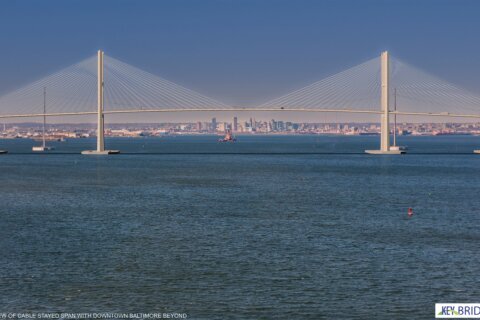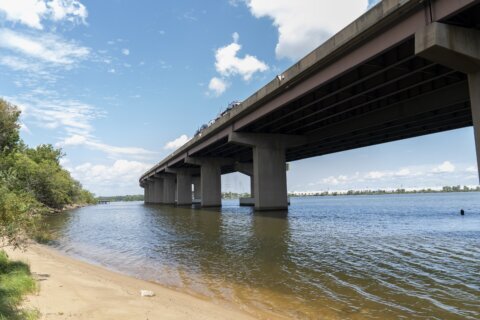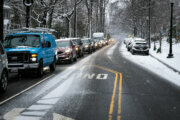Exactly 11 months after the deadly container ship crash and collapse of the Francis Scott Key Bridge, in Baltimore, Maryland, a PBS documentary provides the latest details in the investigation of why the Dali cargo ship lost power — and why the structure collapsed so catastrophically.
“The NTSB found a loose cable,” said Joby Lubman, director of the one-hour “Baltimore Bridge Collapse,” which premieres Wednesday on the PBS science series NOVA.
The film includes never-before-broadcast Port of Baltimore surveillance video from the early morning hours of March 26, 2024, as well as police body-worn camera footage, depicting the minutes before and after the Dali crashed into a support column of the bridge, causing the domino-like collapse of the structure into the Patapsco River, killing six construction workers on the bridge.
“The loose cable caused an initial loss of electrical power to one side of the ship’s power system,” said Lubman, which affected “the fuel pumps, the cooling water pumps and hydraulic pumps for the steering.”
Utilizing information from preliminary reports from the National Transportation Safety Board, as well as interviews with the agency’s lead investigator Marcel Muise, and documents filed in several civil suits, Lubman said “a series of unfortunate occurrences” led to the Dali striking the bridge’s support column.
Investigators believe a switch that would have automatically maintained the ship’s power supply had been flipped to manual during the four minutes between when the Dali initially lost electrical power and the crash.
According to Lubman, investigators said the Dali lost power, twice, the day before the crash, while sitting in the Baltimore port.
“That is when they rerouted the electrical power supply, to the circuit which had this loose cable,” Lubman said.
Bridge collapse ‘could have been prevented’
Completed in 1977, the Key Bridge — the gateway to the Port of Baltimore — was designed and built at a time that container ships were approximately one third the size of the Dali.
“A ship of (Dali’s) size, going at that speed, would have taken out any bridge,” Lubman said.
As to why the bridge collapsed in seconds, structural engineers and investigators said the Dali directly struck a key support column, which triggered the steel arch-shape — continuous through the truss bridge — to tumble into the river.
Lubman said film researchers uncovered notes indicating authorities were aware of the risk.
“The Key Bridge had been hit before, in fact the very same pier had been struck before by a large container ship,” Lubman said. “In 1980, by a ship called Blue Nagoya, which also lost electrical power leaving Baltimore port.”
Also in 1980, the Sunshine Skyway Bridge in Tampa, Florida, collapsed after a freighter hit a support column of the bridge.
Since then, new protection measures have been developed to prevent similar tragedies, including the installation of upgraded concrete protective barriers — referred to as “dolphins” — which are positioned close to the supports to deflect a ship from crashing directly into a column. After 1981, new bridges were required to have dolphins.
In 1977, the Key Bridge was built with four dolphins, but they were located 450 feet away from the supports, said Abi Aghayere, professor of structural engineering at Drexel University. “The dolphins were so far away from the piers that they were basically useless.”
Lubman said local officials had considered upgrading the bridge’s pier protection.
“The harbor safety committee in Baltimore were talking about the vulnerability of the Key Bridge to ship strikes, from 2006 to 2016,” said Lubman, who added film researchers had discovered notes from those discussions.
However, the Key Bridge’s dolphins had not been substantially bolstered since the 1980 Blue Nagoya crash.
“I believe if you had close-up dolphins protecting the Key Bridge, that direct hit from the Dali would not have happened,” Aghayere said in the documentary. “The ship would be damaged, but the bridge would have been spared, the lives would have been spared.”
Asked why the bridge’s pier protection hadn’t been upgraded during the time between 1980 Nagoya crash and the deadly 2025 Dali crash and collapse of the Key Bridge, Lubman said that was a good question: “Clearly the authorities knew that this was a possibility, right?”
NOVA “Baltimore Bridge Collapse” premieres Wednesday, Feb. 26, at 9 p.m. Eastern on PBS, and is available for streaming online at pbs.org/nova and via the PBS app.
Get breaking news and daily headlines delivered to your email inbox by signing up here.
© 2025 WTOP. All Rights Reserved. This website is not intended for users located within the European Economic Area.







